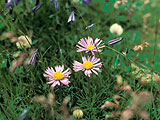 |
|
|
|
|
|
|
Although experiencing a similar climate, the vegetation on siliceous rock differs substantially from that on calcareous rock. Soils are very acidic, commonly deeper (at least at lower alpine elevations), hold more moisture and the number of species found per unit of land area is much smaller. A characteristic ericaceous dwarf shrub belt near the treeline is soon replaced by closed alpine sedge heath, the most characteristic element of the central Alps. |
|
1 - Swiss Alps, Furka Pass, 2500 m. |
|
|
2 - Carex curvula (Cyperaceae), the most common plant species in late successional grass heath of the central Alps (2600 m). |
3 - Pedicularis kerneri (Scrophulariaceae) (Mt. Glungezer, Tyrol, 2600 m) |
4 - Primula minima (Primulaceae), a typical co-dominant of Carex curvula (Cyperaceae) in the E-Alps, but not found in the W-Alps. |
|
5 - Rhododendron ferrugineum (Ericaceae) near the treeline. |
6 - Juncus jaquinii (Juncaceae) (2500 m) |
7 - Aster alpinus (Asteraceae), a representative of the old Tertiary flora of the Alps (2400 m). |
|
8 - Geum reptans (Rosaceae) (2600 m) |
9 - Ranunculus glacialis (Ranunculaceae) |
10 - Saxifraga oppositifolia (Saxifragaceae). |
11 - Cerastium uniflorum (Caryophyllaceae) |
|
12 - Poa alpina ssp. vivipara (Poaceae) |
13 - Leucanthemopsis alpina (Asteraceae) in scree vegetation. |
14 - Soldanella pusilla (Primulaceae), a snow bed species. |
29 August 2011 |
||
| |
||














